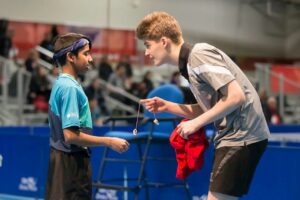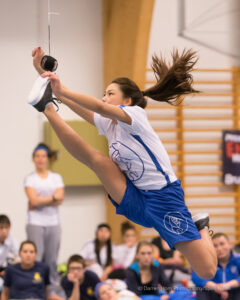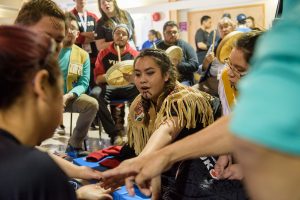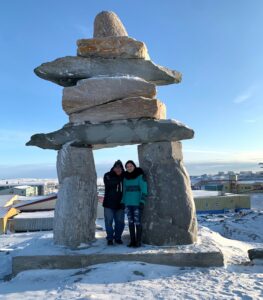Highlights
- Indigenous thought-leader Greg Henhawk discusses the synergy between traditional Indigenous knowledge and holistic approaches to physical literacy
- Henhawk advocates for prioritizing collaboration, rather than solely “inclusion,” when it comes to addressing differences
- Henhawk advises sport (and other) organizations wishing to engage Indigenous communities to prioritize developing a relationship before making any asks
“Teaching was something that I always knew that I could do. From an early age, I was captain of teams and things like that, so I was thrust into leadership roles,” says Greg Henhawk.
Henhawk is a Mohawk of the Bear Clan, from Six Nations of Grand River First Nation, in Southern Ontario. He’s a retired secondary school teacher who spends time engaging, collaborating and consulting with Indigenous and non-Indigenous communities, sport coaches, leaders and program providers across Canada. With a passion for Indigenous philosophy and holistic athlete development, Henhawk is leading the way for physical literacy and long-term development in sport.
As an Indigenous Ambassador, Long-term Development Advisor, and team member for the Physical Literacy with Indigenous Communities project at Sport for Life, Henhawk is actively involved in educational programs and initiatives designed to engage Indigenous people in sport and physical activity. According to Henhawk, Indigenous philosophies offer an approach to physical literacy and long-term development that benefits everyone.
SIRC sat down with Henhawk to discuss how Indigenous ways of knowing and doing can inform an approach to sport that encourages physical literacy and lifelong sport engagement. Here, we share our conversation with Henhawk. Through storytelling, Henhawk conveys the importance of building relationships, promoting diversity and accepting change in sport. This interview was condensed and edited for clarity.
SIRC: Thanks for being with us today. Let’s start by talking about physical literacy. What does it mean to you, Greg?
GH: Physical literacy isn’t a destination, it’s a journey. It’s about developing skills throughout your life that directly impact your life. It’s about being able to accept, embrace and flow with change, as change is one of the only guaranteed aspects of life. I think it’s especially [relevant] to Indigenous people and our holistic way of knowing and doing. It fits our ways of understanding “life balance” and the adaptability needed to regain it, amid factors and conditions changing around us.
There are always differing perspectives when trying to explain physical literacy. For me, it isn’t just doing physical education, sports or recreational activities. Physical literacy is way more holistic than that. It deals with the whole person. It affects the way you feel mentally, emotionally, spiritually and culturally, while you’re active in any way.
And it’s something that’s continual, it’s something that you go through your entire life. It isn’t something that’s one and done. There isn’t one “right” way or a “one size fits all” for everybody. It’s like nature in its diversity. In nature there’s more than one type of tree globally, more than one type of animal and more than just one climate.
Rivers continually flow and change their specific course, but their general course remain consistent from their source to their mouth. As conditions change, rivers and water remain resilient in their path forward, but they also adapt to obstacles.
Physical literacy is going to take on a different role, a different importance depending on the culture, but you’ll find it in every culture. It’s going to manifest itself in a different way from person to person or group to group. It’s completely analogous to an Indigenous (holistic) path through life.
First Nations, Métis and Inuit people traditionally didn’t silo things into mutually exclusive boxes. We looked at relationships in a broad, holistic way. Physical literacy and Indigenous knowledge match each other extremely well.
SIRC: If you were to define physical literacy through an Indigenous lens, what would you say?
GH: A piece I wrote (for the Abilities Centre in Whitby, Ontario, during another physical literacy project) explains the relationship between rivers and water and the lessons they can, and do, teach about life. And since physical literacy is about a journey through life, they’re all related. A knowledge quote I used is from a knowledge keeper here on Six Nations:
“A river is a symbol of travel through time and life. The river stands for the idea that the principles of the law and the relationships they foster can remain constant, even as the temporal, social, and political landscapes change.” (Williams, 2018, p. 48)
Often, I share that which is shared with me. I have to remind people, this isn’t my invented philosophy. I’m simply passing on a philosophy that’s existed for thousands of years.
 Physical literacy is more holistic than just the physical aspect of a person that connects the mind, body, spirit, and physical aspects of being. And like water, it continually flows and contributes to balance in life and overall wellness.
Physical literacy is more holistic than just the physical aspect of a person that connects the mind, body, spirit, and physical aspects of being. And like water, it continually flows and contributes to balance in life and overall wellness.
If you went down to a river today and went in for a swim, or just even walked in and wet your feet, you can go to that same river the next day, and you aren’t in the same water. You’re in different water, but it’s still the same river. There’s constant change in the water as it flows downstream, but it’s still the same river. Consistency and adaptability at the same time. Our pre-settler ideology emphasizes the idea that we must be prepared to adapt, because the only constant thing in the world is change.
I look at physical literacy as the same thing. As you develop, as you go through life, you learn how to walk, you learn how to run, you learn these different skills, and you must learn how to adapt and then learn more.
As you get older you must adapt. I realize that as my body ages, it changes. I must accept that there are some things I’m not going to be able to do, like I did when I was younger. But I can do things to try and keep that from happening, and today I’m capable of things I couldn’t do yesterday.
Change is hard, but it’s possible. An example from sporting life is when professional athletes or someone who’s been involved in something physical for a very long time comes to the end of their competitive career. Often their wellness suffers when they must stop competing within their sport and move on to a new part of their life journey.
Going back to traditional teachings, you’re encouraged to learn to adapt to this eventuality so that you embrace the change (flow downstream) and adjust to this new way of life, rather than fight it. It then becomes a part [of] life you must adapt to throughout life. A river reminds you that life’s a journey and what that journey’s all about.
Those aspects of Indigenous philosophy that were commonplace in the past help frame things like physical literacy. It’s much more than just being physically strong, so that you can be at the top of your game for a particular sport. It’s about overall wellness and balance as you journey through life, learning how to play the game.
SIRC: You’ve said there isn’t an Indigenous translation for “right” and how there are many ways of doing things, not a single “right” way. What do you mean?
GH: It’s true that in our language (as in many First Nations, Inuit and Métis languages), there was no direct word for (or translation or conceptualization of) “right.” The best translation of what we would say is “good.” Over time this may have developed into a word for “right.” But only because there’s been pressure to come up with direct translations for English words and concepts. They lose the true conceptualization in translation. Words have been developed for modern things like cellphones and TV. Things like that wouldn’t be traditional, but they’re also an example of adaptation, although sometimes forced.
Getting back to “right,” the explanation for not having a definitive word relates back to adaptability. Unfortunately, in English the word “right” is definitive. And it’s become dichotomous in a negative way. There’s good and bad or there’s good and evil. So, by saying something is “right” or something is “wrong,” there’s no alternative. There’s no alternative, no diversity, just one way.
 “The Indigenous conceptualization of “good” is also different than in English. One example of good ties in with cycles. Cycles and circles are incredibly important to not only Indigenous art, but also to Indigenous philosophy. The world’s cyclical nature informs and teaches adaptability. A yearly cycle of going around the sun includes the changing of seasons. Even in warmer climates, changes still happen. Cycles are a reminder that things change, but they also return to a balance with the opportunity for renewal. From spring to fall, the leaves change. From the orbit and phases of the moon, water rises and lowers. Within a cycle, things will change, but also return to balance and some aspects change are also constants. There’s no “right” way for that change to happen either. It isn’t going to happen the exact same way every time. Nature functions in a multitude of ways (diverse), it doesn’t only do things one “right” way. Why try for “right,” humans?
“The Indigenous conceptualization of “good” is also different than in English. One example of good ties in with cycles. Cycles and circles are incredibly important to not only Indigenous art, but also to Indigenous philosophy. The world’s cyclical nature informs and teaches adaptability. A yearly cycle of going around the sun includes the changing of seasons. Even in warmer climates, changes still happen. Cycles are a reminder that things change, but they also return to a balance with the opportunity for renewal. From spring to fall, the leaves change. From the orbit and phases of the moon, water rises and lowers. Within a cycle, things will change, but also return to balance and some aspects change are also constants. There’s no “right” way for that change to happen either. It isn’t going to happen the exact same way every time. Nature functions in a multitude of ways (diverse), it doesn’t only do things one “right” way. Why try for “right,” humans?
“Good” also leaves the door open for improvement. If something is good with today’s knowledge (what we know now), then when our knowledge improves (as we learn more), shouldn’t we adapt? A river doesn’t flow on exactly the same path for all of eternity, it changes directions. That doesn’t mean it’s no longer a river. It doesn’t lose the best of what makes it a river. It keeps moving forward toward its ultimate goal, downstream in a better way, a better future.
SIRC: How can thinking about our actions as “good” versus “right” help us create meaningful change in sport?
GH: If you aren’t used to adapting to change, you get entrenched in the “right” way as the only way. Ever. And that can lead to rationalization that we can’t change because it’s going to upset the applecart and that just leads to way too much work!
But times do change and like water flowing downstream in a river, every day there’s new water, but it’s still a river. In a river, factors like the river bottom change, changing from rocky to clay as water travels through different environments. But the water is resilient and doesn’t change its essence. But, it will adjust to new conditions or find a new way when necessary. When there’s resistance to change, often a person’s philosophy (rationalization) has become: “you can’t teach an old dog new tricks.”
If you aren’t used to adapting or changing, you get entrenched in one path, only one “right” way. I believe that’s where the “old dog, new tricks” philosophy stems from. Ultimately, I believe that thinking is driven by the mentality of maximizing profit and spending the least possible. And unfortunately, that translates into: “Don’t take it personally, it’s just business,” which depersonalizes decision-making. It also promotes “I need to obtain and maintain a position of wealth, power and influence” ahead of good relations.
That’s the opposite of traditional Indigenous thought. We don’t want to (and can’t) control nature, which includes controlling people. And nature means diversity and change. Throughout history, there are many examples (negative ones) of humans trying to control nature and people, especially people who were different in culture, spirituality and philosophy. If they didn’t fit the “right” way, then they were automatically bad or evil. Strategies to wipe out or control people who were different were rationalized as dealing with the bad or evil in the “right” way.
Being able to consider the premise “nothing is ever 100% right” opens the possibility for adaptation, even if in small ways. The possibility of change doesn’t mean everything must change or that it will happen all at once (again, think of the changing riverbed). A reason people resist change is fear, either of the unknown or that good will become bad. That’s when “good” strong relationships are needed between all relations (people, animals, earth).
To Indigenous people, medicine is way more than chemicals. Medicine is anything that supports wellness. Good relationships are medicine, including relationships born of diversity, not just similarities.
SIRC: What are the ingredients of a good relationship?
Good relationships require unity. And unity requires three things: a good message, peace and power.
Good message: That’s understanding everyone’s connected with each other and the world that surrounds us (diverse as we may be). We must commit to: respect, trust and friendship. We must transform adversaries into allies. We must insist on equality and reciprocity as integral to Respect”. And remember there isn’t only one “right” way to have a good mind and heart.
Peace: It’s more than just a word. It’s an idea, a process, an action. Peace is health and wellness and it doesn’t stop at a healthy body and good mind. It extends beyond a healthy society to all our relations in our surrounding world. We help one another in many ways, not in one “right” way.
Power: It isn’t what some may think. It’s the power of togetherness within our diversity. A lasting “good” is sustained by establishing relationships and actions that are continually examined, and not just from a single transaction or policy. It’s sustained from the process of continually sharing our diverse voices, languages and thoughts.
Diversity (and not just one “right” way) is served by listening to truths of the past. As difficult as that may sometimes be, it’s a necessary process that seeks to guide actions in the now, and also in the future, for the children and youth we haven’t seen yet! A better place for our children and our children’s children. Seven generations into the future has always been the goal of our ancestors’ wisdom. A good mind and a good heart will always join with other good minds and hearts for that’s where the power lies.
I truly believe there’s momentum for “good” change in sport at the grassroots and mid management level. The top level of decision-making (and funding) seems wary of change, they need our help, they need our medicine. In the near future, I’m hopeful they’ll be open to consider the possibility that good change won’t totally upset their applecart, their world, our world.
Any consideration of change has to be holistic and that means personal (trust, respect and power). And “power” in Indigenous philosophy means the strength of connection intertwined with trust and respect, not just business.
Sport can flow forward in a good way toward a better future when all levels of decision-making and all people are connected and moving toward the same goal. And that leads to considering what is truly meant by Reconciliation, Acceptance of Diversity and Inclusion. In a good way.
SIRC: How can collaboration play a role in equity, diversity and inclusion?
 GH: So, how do we work together? Nature has found a way. I go back to nature, because that’s what our Indigenous thought does. The world over, there isn’t just one tree, one climate, one kind of plant. There isn’t one kind of animal that has taken over and made everything the same. There’s diversity in nature. And there’s balance in nature too, it finds a way.
GH: So, how do we work together? Nature has found a way. I go back to nature, because that’s what our Indigenous thought does. The world over, there isn’t just one tree, one climate, one kind of plant. There isn’t one kind of animal that has taken over and made everything the same. There’s diversity in nature. And there’s balance in nature too, it finds a way.
Globally, throughout time I think philosophy and leadership hasn’t asked “How do you deal with differences in a good way?” Instead, it’s been: “Let’s get rid of the difference and do it our way, the ‘right’ way.”
When settlers first arrived, the Haudenosaunee (also known as the Iroquois) developed an agreement with the settlers detailing how their relationship would exist moving forward. It’s recorded with the “Two Row Wampum” (two parallel lines, close together, continuing in the same direction).
Essentially, the two lines represent two water vessels (one Indigenous and one non-Indigenous) flowing in the same direction (future). They’re close together, representing sharing and knowing each other very well. The lines never cross, never become one, nor diverge. Several concepts were embedded in these lines. Neither culture will impose its will on the other (tell them what to do), there shouldn’t be conflict between them, nor should they change their unity by moving apart (power or strength exists in good relationships). The lines’ proximity represented working together, but still retaining their own unique identity.
Would this have been an agreement with Savages? I don’t think so. Indigenous people weren’t Savages when settlers first arrived (we had our conflicts in the past, but had moved past that history). The Haudenosaunee had the “Great Law of Peace!” But, we definitely had differences.
We helped them; we helped settlers survive in ecosystems that were foreign to them. We showed them how to survive in this climate, we showed them foods that could give them vitamin C so they wouldn’t die of scurvy. We showed them all kinds of things when they first came here. We didn’t attack them when they first came here. The perception of who we were when they first arrived is misleading.
Despite not being considered people in Constitution of Canada and the British North America Acts until 1952, I still believe the good path forward is through collaboration, true partnerships where everyone has an equal voice at a table, not just simply a seat at the table without voice. We help one another. Collaboration also means we work with differences and diversity, rather than trying to make everybody the same.
SIRC: What advice would you leave our readers about enhancing their physical literacy and sport programming?
Begin with the premise that “people are people first.” And then learn to communicate by speaking with people rather than at them. Begin the long process of unpacking the past’s uncomfortable truth by not only learning surface culture but deep culture as well. Create trust and respect by listening for understanding, as opposed to listening to simply respond. Build strong relationships first. There will be plenty of time to talk business second.
Trust in the possibility of good change and the inevitability of change. It’s part of the cycle of life. Never forget that physical literacy, sport and people are all interconnected in a holistic way, not simply in a checkbox or acknowledgement. Be adaptable and creative. Change will happen, albeit in small ways and small cycles, and over large cycles and generations.
All people are guided by and exist for a better future for our children and youth, far into the future. That’s the power that binds us.